What Animals Does Mongolia Currantly Have What Animals Does Mongolia Currently Have
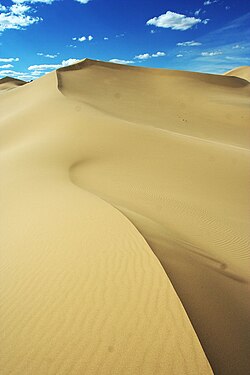
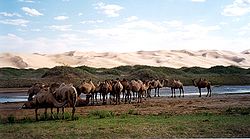
Bactrian camels in the sand dunes of Khongoryn Els, Gobi Gurvansaikhan National Park, in Ömnögovi Province.
The wildlife of Mongolia consists of unique flora and fauna in 3092.75 habitats dictated by the diverse and harsh climatic conditions found in the country. So the north, salty marshes, fresh-water sources, desert steppes at the centre, and semi deserts, as well every bit the hot Gobi desert in the southward, the 4th largest desert in the world.[i] [2]
About 90 pct of this landlocked land is covered past deserts or pastures with extreme climatic weather condition; this desert expanse is the largest temperate grassland habitat. Creature reported in the wild consists of 139 mammal species, 448 species of birds (including 331 migratory and 119 resident birds), 76 species of fish, 22 reptile species, and six species of amphibians.[1] [3] [4] Grass land and shrubland covers 55 pct of the state, forest covers simply 6 per centum in the steppe zone, 36 percent is covered by desert vegetation, and only 1 percent is used for human habitation and agricultural purposes, such equally growing crops.[iii] The floral vegetation in the Eastern Steppe temperate consists of grassland (the largest of its blazon in the world).[5]
Geography [edit]
Topography [edit]
The country is bounded by many zoogeographic regions adjoining Tibet, Afghano-Turkistan, Siberia, and the N-Chinese-Manchurian. This has resulted in a faunal richness that combines the species from each of the edge nations.[6] Habitat distribution consists of grassland and shrubland and treeland in an expanse of 55 percent of the country, while forest cover is only 98 per centum in the steppe zone, 36 percent is covered by desert vegetation.
H2o resources [edit]


Panoramic view of Lake Khövsgöl
The drainage blueprint in the state is dictated by the continental split. This separates areas that drain northward to the Arctic Ocean from those that drain northeast into the Pacific Ocean. The Khangai Mountains form another divide between areas that drain into the oceans and those that drain inland. In the western and southern zones, streams flow seasonally into salt h2o lakes without outlets. Rivers of the northern region are perennial, rising from the mountains. The two major river systems are the Orkhon River (Mongolia's longest inland river within the country, which joins the Selenge River) and the Selenge River (Selenga in Russian). Lakes in the land are generally saline. The largest by volume is freshwater Lake Khövsgöl, a natural lake formed in a structural depression.[vii] It is the second oldest lake in the world and accounts for 65 per centum of the fresh water of Mongolia (ii per centum of that in the globe).[8]
Climate [edit]
The climatic conditions dictated past the oceans on 1 side and the snow-capped mountains (average elevation elevation of v,180 metres (xvi,990 ft) in high northern latitudes) on the other side, have a significant bearing on the wild fauna distribution in the country. The climate patterns are: Continental climate with very common cold conditions (anticyclones are formed here over Siberia) to absurd to hot summers in the deserts and semi deserts. Temperature records indicate a very wide variation between wintertime and summer, of the guild of eighty °F (44 °C) on an average in the northern function of the country, and even on a single day the variation tin be equally much as 55 °F (31 °C). In the Ulaanbaatar area the variation reported is −7 °F (−22 °C) in January and 63 °F (17 °C) in July while in the Gobi desert expanse, the average temperature reported for January is 5 °F (−15 °C) and 7 °F (−14 °C) in July.[7]
Precipitation [edit]
Rainfall and snowfall are also very uneven, dependent on elevation and latitude. With annual amounts ranging from less than in some low-lying desert areas of the south and westward it is less than four inches (100 mm). In the northern mountainous area it is reported every bit about 14 inches (360 mm) while at Ulaanbaatar the reported annual rainfall is 10 inches (250 mm). The number of days the heaven remains clear and sunny is between 220 and 260 days annually. Snow occurs in the mount regions in the class of "fierce blizzards" that also embrace the steppes. During this period a thin layer of snow totally stops grazing past animals in these pastures.[seven]
Legal protection [edit]
Commercial exploitation increased between the seventeenth and twentieth centuries, necessitating increased legislation. Two laws were enacted in 1995, the Mongolian Police force on Ecology Protection and the Mongolian Constabulary on Hunting.[9] The steppe habitat for Mongolian gazelle (Procapra gutturosa), an area of 275,000 square kilometres (106,000 sq mi), is reported to be the "largest remaining instance of a temperate grassland ecosystem".[10]
Protected areas [edit]

View from the monastery at Gorkhi-Terelj National Park
Immediately later Mongolia attained independence in 1990, the enthusiasm was to declare 100 per centum of the area of the land as a national park. However, the figure was pegged at an achievable 30 percent. But due to economic weather dictating development of mines, the accomplishment and so far has been of the order of xiii.8 percent covering an expanse of 215,200 square kilometres (83,100 sq mi) spread over 60 protected areas. At that place are four categories of protected areas, and these are: Strictly Protected Areas (prohibiting hunting, logging and development with no man home as the divers areas are very delicate eco regions); the National Parks, with their historical and educational interest providing for ecotourism in identified areas and with limited access to the local nomads for fishing and grazing; Natural and Celebrated Monuments with restricted developmental activities; and Nature Reserves though of less of import regions addressed issues of providing protection to endangered and rare species of flora and animal and archeological value with express access for development within prescribed guidelines.[11] The Strictly Protected Areas are Bogd Khan Uul Biosphere Reserve (covering 67,300 ha including buffer area and transition expanse and established in 1996[12]), Peachy Gobi Reserve (expanse of 985,000 ha of cadre area, established equally Reserve in 1975 and equally Biosphere reserve in 1990[thirteen]), Uvs Nuur Basin Reserve (covers a total expanse of 810,233.v hectares (2,002,131 acres) in 1997 as biosphere reserve[fourteen]), Dornod Mongol Biosphere Reserve (covers a total area of 8,429,072 ha equally biosphere reserve designated in 2005[fifteen]) and Khustain Nuuru Reserve (established in 2003 roofing an area of 50,600 hectares (125,000 acres)). They are all biosphere reserves under the Man and the Biosphere Programme.[11]
Autonomously from the above Biosphere reserves, some of the other protected areas under the above four categories are the post-obit.[sixteen]
- Strictly Protected Areas

Otgon Tenger Mountain in the Strict Protected reserve
- Khasagt Khayrkhan (27,400 hectares (68,000 acres))
- Khukh Serkhiin Nuruu (65,900 hectares (163,000 acres))
- Khan Khentii Uul (ane,227,000 hectares (3,030,000 acres))
- Otgon Tenger Reserve (95,500 hectares (236,000 acres))
- Numrug (311,200 hectares (769,000 acres))
- Mongol Daguur (103,000 hectares (250,000 acres))
- National Parks
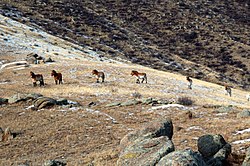
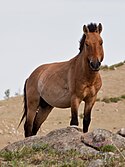
- Gobiin Gurvan Saykhan (2171737 ha)
- Khovsgul Nuur (838,100 hectares (2,071,000 acres))
- Khorgo Terkh Zagaan Nuur (77,267 hectares (190,930 acres))
- Gorkhi Terelj (286,400 hectares (708,000 acres))
- Altai Tavan Bogd National Park
- Tsambagarav Uul National Park
- Khustain Nuruu National Park
- Lake Khövsgöl National Park
- Southern Altai Gobi National Park
- National Reserves
- Ugtam Uul (46,160 hectares (114,100 acres))
- Lkhachinvandad Uul (58,800 hectares (145,000 acres))
- Bulgan Gol (vii,700 hectares (19,000 acres))
- Sharga and Mankhan (316,900 hectares (783,000 acres))
- Khustain Nuruu (49,940 hectares (123,400 acres))
- Nagalkhan Uul (three,000 hectares (7,400 acres))
- Batkhan Uul ha
- Gun-Galuut Nature Reserve
- National Monuments
- Eej Khairkhan (22,500 hectares (56,000 acres))
- Bulgan Uul (one,800 hectares (4,400 acres))
- Togoo Tulga Uul (ane,665 hectares (iv,110 acres))
- Naiman Nuur (11,500 hectares (28,000 acres))
- Ganga Nuur (32,860 hectares (81,200 acres))
Flora [edit]

The flora in the wildlife area of Mongolia is of pasture lands in 3-fourths of the country, which is the main source of feed for the large stock of livestock in the land. Forests and barren deserts cover the remaining surface area in the country.[17] Specifically there are four vegetation zones. Coniferous forest course the taiga region of the northern areas with tall noted at college zones. In the mountain forest-steppe zone vegetation is dense on the northern slopes; Siberian larches (grows up to 45 metres (148 ft) peak[18]), Siberian cedars, interspersed with spruces, pines (Siberian and Scotch pines), and firs forth with deciduous vegetation of white and chocolate-brown birches, aspens, and poplars are noted to dominate the surface area. The inter-montane basins, wide river valleys and the southern slopes of the mountains have steppe vegetation. Pastureland take a cover of plumage grass, burrow grass, wormwood, and several species fodder plants. In the semi desert and Gobi desert areas, the vegetation is scanty just just adequate for the camels, sheep and goat populations to feed on and survive. Saxaul (xerophytic) a drought-tolerant species is also noted and it provides for the firewood requirements of the people. Elms and poplars are also found most springs and underground h2o resource.[seven] Saxaul shrubs dominate the deserts and they ballast the sand dunes and prevent erosion. It grows to height of 4 thou, over a menstruum of 100 years, with very dense wood that sinks in h2o. Rhododendrons blossom with red, xanthous and white wild flowers and edelweiss is also reported. More than than 200 establish species are reported as under threat.[18]
Fauna [edit]
There are 139 mammal species found in Mongolia, and 448 species of birds.[ane]
Mammals

Mongolia has a number of large mammals, including gray wolves and Siberian ibex (Capra sibirica), as well every bit more than endangered species such as the wild Bactrian camel (Camelus ferus), the snow leopard (Uncia uncia), the Gobi conduct, (rarest and unique to the desert region), the takhi (both wild and domestic types of horses) and the Asiatic wild ass (the largest numbers in the globe are found in the Gobi desert).[1]
The saiga antelope, in one case a mutual species, has been reduced by pressures including hunting, livestock grazing, and high Chinese medicinal value, with the Mongolian subspecies reaching a critically endangered level, with fewer than 5,000 individuals left in the wild.[four] The wild horse, in item, had almost become extinct (non seen for more three decades) and was therefore reintroduced from captive sources. Other species of mammals reported include: argali (Ovis ammon) (in the rocky mountains of the Gobi desert), common wolf, Mongolian saiga (Saiga tatarica mongolica), musk deer (Moschus moschiferus), Pallas's cat (Felis manul) or manul, blackness tailed gazelle (Gazelle subgutturosa), rock martin (Martes foina), and wild cats in the Altai ecoregion; wild boar (Squealer nigipes), red deer (Cervus elaphus), roe deer in the forest areas and muskrat, red fox, steppe fox, and sable in the forest and steppe margin areas.[ane] [19]
Under the WWW-Mongolia conservation programme (a four-twelvemonth project), snow leopards, Altai argali sheep and saiga antelope and gazelle of eastern Mongolia are receiving special attention.[19] The Zoological Lodge of London has taken involvement to conserve Bactrian camel, long-eared jerboa (Euchoreutes naso), Mongolian gerbil ("meriones unguiculatus") and saiga antelope.[20]
Birds [edit]

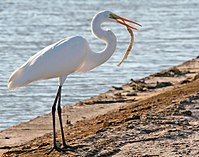
Left: A spoonbill; right: a great white egret
The bird species in Mongolia include several that are very large; six species of cranes present account for half the numbers in the globe.[4] There are 22 endangered species of birds including hawks, falcons, buzzards, cranes and owls. Though cranes are not hunted for superstitious reasons, they are notwithstanding threatened due to habitat degradation and but 5000 breeding pairs are reported, mostly in Dornod'due south Mongol Duguur Strictly Protected Area. In eastern Mongolia, a critically endangered species of crane is the white naped crane (Tsen togoru).[21] Overall there are 469 species of birds, including domesticated species linked to wild ancestral species. Of these, 330 species are migratory and 119 are seen in Mongolia throughout the year.[v] Species identified include:[xix] golden eagle (Aquila chrysaetos), lammergeyer (Gypaetus barbatus), spoonbills (Platalea leucorodia), Dalmatian pelican (Pelecanus crispus), corking white egrets (Egretta alba), whooper swans (Cygnus cygnus), neat black-headed gulls (Larus ichthyaetus), black storks (Ciconia nigra), swan goose (Anser cygnoides) and snowcock (Tetraogallus altaicus) or Altain ular.[19]
Aquatic life [edit]
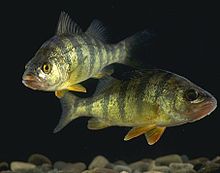
The rivers and lakes of Mongolia are reported to have 76 species of fish, including trout, grayling ( khadran ; the Arctic grayling and the Mongolian grayling can be widely establish in Mongolian rivers[22]), roach,[23] : 213 lenok ( zebge ), Siberian sturgeon ( khilem ), pike[23] : 210 ( tsurkhai ), perch ( algana ), Altai osman (endemic to the rivers of Mongolia[22]) and the taimen (a huge Siberian salmon relative, growing up to 1.five m in length and fifty kg in weight).[21]
Threats and conservation [edit]
In a country where Russia was supporting the economy with grants until it became independent in 1990, the situation drastically inverse after independence. The land's revenue resources then depended more from the wild animals resource and its landscape, which were subject to serious exploitation necessitating a policy change towards ecotourism to generate revenue to preserve the remaining biodiversity of the country.[24] Other than official action to enhance resources of the land, other major threats faced are illegal hunting (for musk deer, elk, boars, squirrels and marmot for illegal trade), grazing of pasture livestock and related needs of water resource (due to big increase in livestock population since 1990), climate alter, fires in steppe and forests (resulting in death of many animal species) and severe weather atmospheric condition of winter and drought status.[25]
For conservation of the rich biodiversity of the country Government of Mongolia has established national parks and nature reserves supplemented with laws on hunting regulations and other conservationist measures, and also on hunting and line-fishing for sport and for commercial purposes.[6]
References [edit]
- ^ a b c d east "Wild life". National Geographic Offroad Expeditions Wild life. Retrieved 1 May 2013.
- ^ Guek Cheng Pang (2010). Mongolia. Marshall Cavendish. pp. 58–. ISBN978-0-7614-4849-v . Retrieved i May 2013.
- ^ a b Michael Kohn (2008). Mongolia. Ediz. Inglese. Lonely Planet. pp. 49–. ISBN978-one-74104-578-9 . Retrieved ane May 2013.
- ^ a b c "Mongolia". Wildlife Conservation Club. Retrieved 1 May 2013.
- ^ a b "Wild Life Issues in Mongolia". Iberia nature.com. Retrieved 1 May 2013.
- ^ a b "Mongolia: Beast life". Encyclopædia Britannica, Inc. Retrieved 2 May 2013.
- ^ a b c d "Mongolia: Drainage". Encyclopædia Britannica, Inc. Retrieved 2 May 2013.
- ^ Kohn 2008, pp. 50–51.
- ^ Badarch, Dėndėviĭn; Zilinskas, Raymond A.; Balint, Peter J. (2003). Mongolia Today: Science, Civilisation, Surround and Evolution. Psychology Press. pp. 41–. ISBN978-0-7007-1598-5 . Retrieved 30 April 2013.
- ^ Olson, Kirk A. (2008). Ecology and Conservation of Mongolian Gazelle (Procapra Gutturosa Pallas 1777) in Mongolia. University of Massachusetts Amherst. ISBN978-0-549-78947-5 . Retrieved 30 April 2013.
- ^ a b Kohn 2008, p. 52.
- ^ "Bogd Khan Uul Biosphere Reserve". UNESCO Organization. Retrieved 3 May 2013.
- ^ "Bang-up Gobi Biosphere Reserve". UNESCO Arrangement. Retrieved iii May 2013.
- ^ "Uvs Nuur Basin, Russian federation, Republic of Tuva and Mongolia". Encyclopaedia Earth System. Retrieved 3 May 2013.
- ^ "Dornod Mongol Biosphere Reserve". UNESCO Organization. Retrieved 3 May 2013.
- ^ "The National Parks and Nature Reserves of Mongolia". Nationalparks-worldwide.info. Retrieved 3 May 2013.
- ^ "Mongolia". Encyclopædia Britannica . Retrieved two May 2013.
- ^ a b Kohn 2008, p. 51.
- ^ a b c d "Wild fauna in Mongolia:Species Conservation work with WWF Mongolia". World Wildlife Fund. Retrieved one May 2013.
- ^ "Mongolia". The Zoological Society of London. Retrieved two May 2013.
- ^ a b Kohn 2008, p. 50.
- ^ a b Blunden, Jane (2008). Mongolia: The Bradt Travel Guide (2 ed.). p. 208. ISBN9781841621784.
- ^ a b Petr, T., ed. (1999). Fish and fisheries at higher altitudes : Asia. Rome: FAO. ISBN92-v-104309-four.
- ^ Kohn 2008, p. 48.
- ^ "Wild Life Bug in Mongolia" (PDF). WWF Mongolia Programme Part. Retrieved ii May 2013.
Bibliography [edit]
- Michael Kohn (2008). Mongolia. Ediz. Inglese. Lonely Planet. pp. 51–. ISBN978-one-74104-578-ix . Retrieved 2 May 2013.
Source: https://en.wikipedia.org/wiki/Wildlife_of_Mongolia#:~:text=Mongolia%20has%20a%20number%20of,and%20domestic%20types%20of%20horses
Posted by: callenderrobef1979.blogspot.com

0 Response to "What Animals Does Mongolia Currantly Have What Animals Does Mongolia Currently Have"
Post a Comment